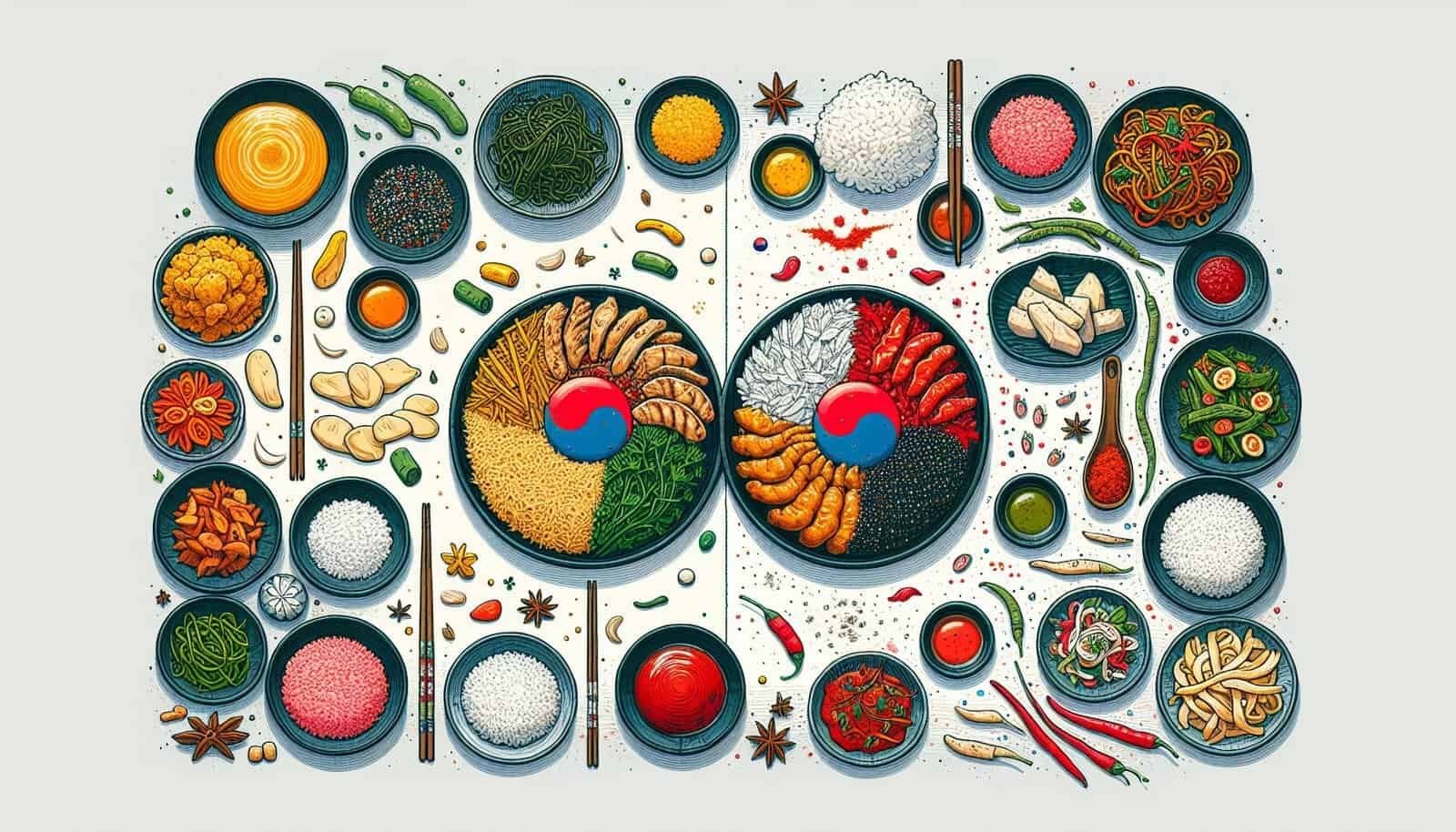In this article, we will explore the fascinating world of North and South Korean cooking styles and uncover the key differences that set them apart. From the flavors and ingredients used, to the cooking techniques and cultural influences, you will gain a deeper understanding of how these two regions have developed their unique culinary traditions. Whether you’re a food enthusiast or simply curious to learn more about Korean cuisine, join us on this flavorful journey as we explore the intriguing contrast between the North and South Korean cooking styles.
Ingredients
North Korean Ingredients
North Korean cuisine heavily relies on locally sourced ingredients due to its limited access to imported goods. Common ingredients include rice, corn, potatoes, soybeans, and various vegetables grown in the region’s fertile lands. Seafood, specifically dried fish, is also prominent in North Korean dishes. Despite the scarcity of ingredients, North Koreans possess an impressive ability to create delicious dishes using what is available to them.
South Korean Ingredients
In South Korean cuisine, there is a wider range of ingredients available due to its access to international trade. Rice, soybeans, and vegetables such as cabbage, lettuce, and radishes are commonly used. Additionally, South Koreans incorporate a variety of meats into their dishes, including beef, pork, and chicken. Seafood also plays a significant role in their cuisine, and they utilize different types of fish and shellfish in their traditional meals.
Flavors and Seasonings
North Korean Flavors and Seasonings
North Korean cuisine focuses on preserving and enhancing the natural flavors of the ingredients. Subtle yet significant flavors are achieved through various methods such as fermentation and pickling. Essential seasonings include soy sauce, sesame oil, garlic, ginger, and dried red chili. These ingredients bring a depth of flavor to North Korean dishes, showcasing a balance between savory, salty, and slightly spicy tastes.
South Korean Flavors and Seasonings
South Korean cuisine is renowned for its bold and distinct flavors. Fermented ingredients like soybean paste (doenjang), chili paste (gochujang), and soy sauce play a crucial role in adding rich flavors to dishes. Garlic, ginger, sesame oil, and scallions are commonly used for seasoning, elevating the taste profile. South Korean cuisine is known for its spiciness, as red pepper flakes and fresh chili peppers are often used to give dishes a fiery kick.

Popular Dishes
North Korean Popular Dishes
North Korean cuisine offers a unique blend of flavors and textures in their popular dishes. One of the most well-known dishes is Pyongyang Naengmyeon, a cold noodle dish served with sliced beef, pickled radish, and a tangy broth. Another popular dish is Bibimbap, a colorful bowl of mixed rice topped with assorted vegetables, meats, and a spicy sauce. Additionally, Kimbap, which resembles sushi, is a beloved snack in North Korea, made with rice, vegetables, and sometimes meat or seafood, rolled in seaweed.
South Korean Popular Dishes
South Korean cuisine boasts a multitude of popular dishes that have gained worldwide recognition. Kimchi, a staple side dish made of fermented cabbage or radishes with chili pepper, is a symbol of South Korean cuisine. Another beloved dish is Bulgogi, thinly sliced marinated beef or pork cooked on a grill. Samgyeopsal, a dish consisting of grilled pork belly, is also popular among Koreans. Other favorites like Japchae (stir-fried glass noodles) and Tteokbokki (spicy rice cakes) complete the diverse array of delectable South Korean dishes.
Rice and Noodles
North Korean Rice and Noodles
Rice is a staple food in North Korean cuisine, often forming the basis of meals. The preparation of rice varies, with different cooking methods producing different textures. North Korean-style rice is typically stickier, which allows for easier consumption using chopsticks. Noodles, particularly buckwheat and sweet potato noodles, are also commonly enjoyed in North Korean cuisine. These noodles are often used in cold dishes, providing a refreshing and satisfying meal option.
South Korean Rice and Noodles
Similar to North Korea, rice is a fundamental part of South Korean cuisine. It is often steamed and serves as the main component of a meal, accompanied by various side dishes. South Koreans prefer slightly separate, fluffy grains of rice. Noodles in South Korean cuisine come in a wide variety. From the famous Jjajangmyeon, noodles coated in a black bean sauce, to the iconic Ramyeon, instant noodles known for their spiciness, noodles hold a special place in South Korean culinary culture.

Cooking Methods
North Korean Cooking Methods
In North Korean cuisine, cooking methods prioritize preserving the natural flavors of the ingredients. Boiling, steaming, and stewing are commonly used to retain the nutritional value. Soup dishes are prevalent, as boiling ingredients slowly allows flavors to meld together. Grilling is also popular, especially for meats and seafood, adding a smoky aroma to the dish. Fermentation and pickling are traditional techniques used to preserve food and enhance its taste, giving North Korean cuisine its unique character.
South Korean Cooking Methods
South Korean cuisine encompasses a wide range of cooking methods that contribute to its diversity. Stir-frying, deep-frying, grilling, and braising are some of the common techniques utilized. Stir-frying enables a quick cook time while retaining the natural flavors and textures. Deep-frying creates crispy and savory dishes, often enjoyed as street food. Grilling imparts a smoky taste to meats and vegetables, while braising slowly cooks ingredients in a flavorful broth, resulting in tender and succulent dishes.
Meal Structure
North Korean Meal Structure
In North Korean cuisine, meals usually consist of rice or noodles as the primary carbohydrate source. Accompanying the main dish are various side dishes, including cooked vegetables, soups, and pickles. The meal structure revolves around achieving a balance of flavors, nutrients, and textures. In traditional North Korean etiquette, serving dishes in odd numbers is common, symbolizing abundance and good fortune. The communal aspect of dining is highly valued, with shared dishes enhancing the sense of togetherness during mealtimes.
South Korean Meal Structure
South Korean meals are characterized by a diverse selection of dishes served in a shared dining style. A typical meal consists of rice, soup, several side dishes called banchan, and usually a main dish or protein source. Banchan can vary from pickled vegetables to stir-fried dishes and fermented foods, including the famous kimchi. The balanced combination of flavors, colors, and textures ensures a satisfying and nutritious meal. South Koreans take pride in providing a wide variety of dishes to demonstrate their hospitality and care for guests.

Kimchi
North Korean Kimchi
Kimchi holds immense cultural significance in North Korean cuisine, just as it does in South Korean cuisine. However, North Korean kimchi tends to be milder in taste and less spicy compared to its southern counterpart. Napa cabbage is the most commonly used vegetable in North Korean kimchi, along with radishes and other seasonal vegetables. The fermentation process of kimchi in North Korea may be shorter, resulting in a less pungent flavor.
South Korean Kimchi
Kimchi is often considered the national dish of South Korea. It is prepared by fermenting vegetables, usually Napa cabbage or radishes, in a spicy mixture of chili pepper, garlic, ginger, and other seasonings. South Korean kimchi is known for its spiciness, giving dishes a fiery kick. Fermentation is essential for developing the distinct tangy flavor that characterizes South Korean kimchi. The versatility and nutritional value of kimchi make it an integral part of South Korean cuisine.
Influence of Neighboring Countries
North Korean Influence
North Korean cuisine has been significantly influenced by its neighboring countries, particularly China and Russia. Chinese culinary techniques, such as stir-frying and using soy sauce, have made their way into North Korean cooking. The Russian influence is evident in the use of ingredients like potatoes and beets, which were introduced during the Soviet era. This blend of influences has resulted in a unique fusion of flavors and ingredients in North Korean cuisine.
South Korean Influence
South Korean cuisine has also been shaped by its neighboring countries, particularly China and Japan. Chinese influence is evident in the use of noodles, stir-frying techniques, and the concept of side dishes. From Japan, South Korea adopted the art of fermentation and the idea of presenting food in visually appealing ways. These influences have played a crucial role in shaping the vibrant and diverse culinary landscape of South Korea.

Presentation and Garnishes
North Korean Presentation and Garnishes
North Korean cuisine embraces simplicity in presentation, focusing on allowing the natural colors and textures of the ingredients to shine through. Dishes are often presented in a balanced and orderly manner, showcasing an aesthetic appeal. Garnishes commonly include green onions, sesame seeds, and red chili flakes, adding subtle pops of color and enhancing the overall visual appeal of the dish.
South Korean Presentation and Garnishes
Presentation is highly regarded in South Korean cuisine, where dishes are meticulously arranged to be visually appealing. The vibrant and colorful banchan, presented in small bowls, complement the main dish and rice. Garnishes like sliced vegetables, edible flowers, and seaweed strips are used to add decorative elements to the plate, elevating the dining experience. The attention to detail in presentation reflects the importance of food aesthetics in South Korean culture.
Availability of Ingredients
North Korean Ingredient Availability
Due to international sanctions and limited trade, North Korea perceives challenges in accessing a wide range of imported ingredients. The reliance on locally sourced ingredients has led to a strong emphasis on self-sufficiency and creative use of available resources. Despite these limitations, North Koreans have discovered innovative ways to make delicious dishes with the ingredients at hand.
South Korean Ingredient Availability
South Korea benefits from a more open and global market, enabling a wider range of ingredients to be available. The accessibility to imported ingredients from various countries has expanded the culinary landscape of South Korean cuisine. This abundance of diverse ingredients allows for greater experimentation and fusion with traditional recipes, resulting in unique and exciting dishes.
In conclusion, while North and South Korean cuisines share some similarities, they also possess distinct characteristics that set them apart. North Korean cuisine focuses on utilizing local ingredients and achieving a balance of flavors through fermentation and pickling techniques. South Korean cuisine, on the other hand, showcases bolder and spicier flavors, along with a wider variety of ingredients. Both cuisines value the communal aspect of dining and take pride in the presentation of dishes. Although North Korea faces challenges in ingredient availability, it has become adept at creating delicious dishes with limited resources. South Korea, with its access to international trade, continually pushes the boundaries of culinary innovation. No matter which side of the border you’re on, both cuisines offer a truly delicious and diverse experience.

